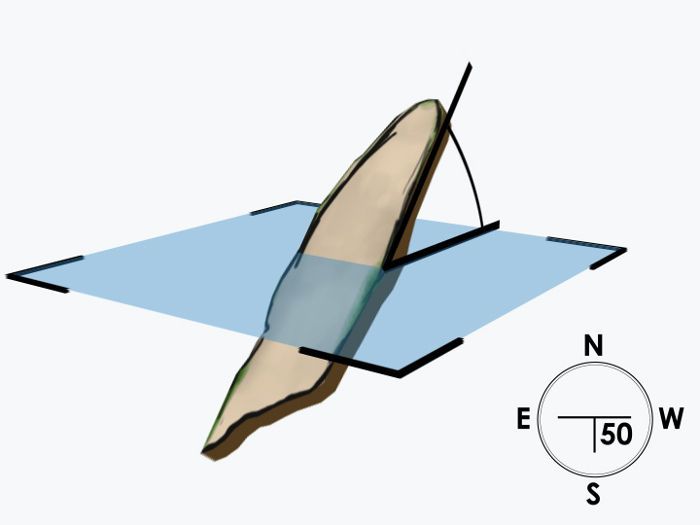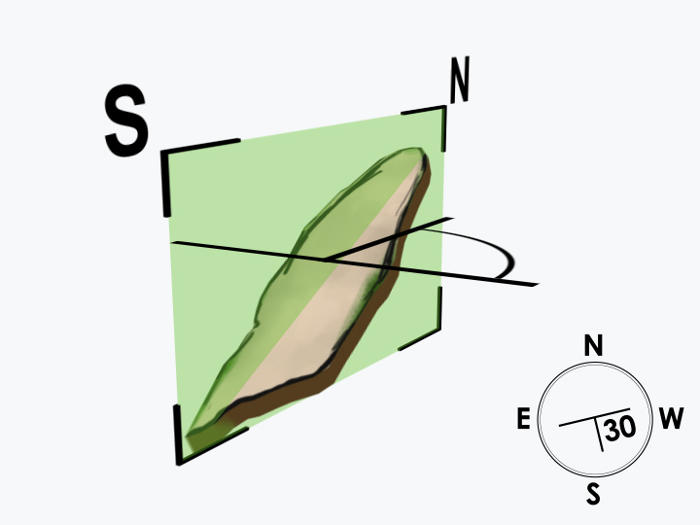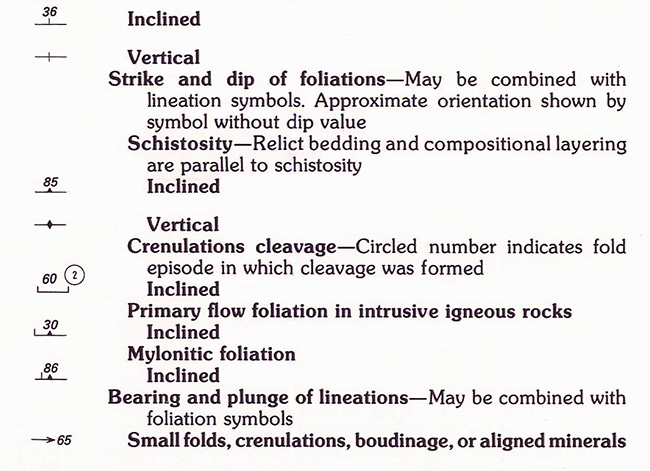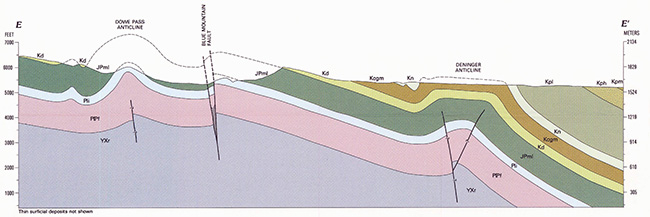Détermination de l'orientation spatiale des couches rocheuses avec la boussole Brunton
Vue d'ensemble
Source : Laboratoire de Alan Lester - Université du Colorado Boulder
La plupart des unités lithologiques présentent une forme de surfaces planes ou caractéristiques linéaires. Exemples incluent literie - faute-, fracture-et joint-surfaces et diverses formes d’alignement foliation et minérale. L’orientation spatiale de ces éléments forment les critiques données brutes utilisées pour contraindre les modèles traitant de l’origine et la déformation subséquente des unités lithologiques.
Bien que maintenant plus de 100 ans depuis son invention et l’introduction, la boussole Brunton (Figure 1) reste un outil central dans l’arsenal de la géologue moderne d’équipements de terrain. C’est toujours le principal outil utilisé pour générer des données de terrain concernant l’orientation géométrique des surfaces planes de roche ou des caractéristiques de la roche linéaires. Ces mesures d’orientation sont appelés grève tremper et fournir des données fondamentales pour faire des cartes géologiques. Par ailleurs, la boussole Brunton peut également fonctionner comme une boussole traditionnelle pour les exercices de localisation et de triangulation. Enfin, il peut également servir un transit de poche pour mesurer les altitudes angulaires.

La figure 1. La boussole Brunton.
Principles
La plupart de couches de roche (couches sédimentaires, superposition de roches ignée ou des bandes/foliation métamorphique) peuvent être décrit comme une surface plane dans l’espace. Par conséquent, la surface a une déviation angulaire de l’horizontal de n’importe où entre 0° et 90°. Cette déviation angulaire est connue comme « dip » (Figure 2). Toutes les surfaces rocheuses qui ont supérieure à pendage 0° ont une intersection linéaire avec un plan horizontal imaginaire, et la boussole direction de cette intersection linéaire (la ligne formée par l’intersection de la couche de roche et un plan horizontal) est dénommée « grève » (Figure 3).
Pour déterminer la grève et le pendage d’une surface rocheuse, la boussole Brunton doit être correctement préparée et ensuite alignée avec la surface en cours d’évaluation.

La figure 2. La trempette, ou un écart par rapport à l’horizontale, d’une caractéristique géologique.

La figure 3. La grève, ou une déviation du Nord, d’une caractéristique géologique.
Procédure
1. préparation
- Vérifiez gratuitement mouvement aiguille. Vérifiez que l’aiguille est sans entrave dans le plan horizontal. Certaines boussoles ont des boutons de bride qui maintiennent l’aiguille en place, et le cas échéant, vérifiez que pousser la bride ne bouge pas l’aiguille.
- Vérifier le centrage de la « bulle de l’oeil de boeuf » et la continuité. Cette bulle est l’un des deux bulles de nivellement et sert à déterminer l’horizontalité de la boussole. Autre la bulle est utilisée pour les mesures de l’inclinaison.
- Vérifier la configuration correcte de déclinaison magnétique. Étant donné que les pôles magnétiques et géographique de la terre ne coïncident pas, afin d’évaluer avec précision les points cardinaux (par rapport au nord vrai) l’axe de déclinaison doit avoir la valeur de la déclinaison magnétique correcte pour l’emplacement de son utilisation.
2. établir la Surface représentant appropriée pour la mesure
- Dans le champ, un géologue doit établir les surfaces représentatives adaptées pour la mesure. L’idée est de rapprocher l’orientation générale de la fonction en cours d’évaluation (literie, jointage, foliation, etc.) à cet endroit particulier. Une des façons plus simples de le faire est de placer un ordinateur portable ou le presse-papiers sur la roche dans cette orientation moyenne et représentative.
Dans une démonstration de laboratoire, n’importe quelle surface plate peut servir comme une surface représentative (un Conseil/modèle sur un bureau ou un élément architectural d’un bâtiment).
3. Réglez la boussole sur la Surface
- Ensuite, le bord inférieur de la boussole Brunton est fixé sur la surface, telle que la totalité de l’arête est affleure la surface.
4. Centre de la « bulle de l’oeil de boeuf »
- Sans prendre n’importe quelle partie de ce bord au large de la surface (une erreur commune) la boussole Brunton tourne jusqu'à ce que la « bulle de mouche » est centrée.
5. Lisez l’Orientation Azimith, ou mesurer la grève
- En centrant la bulle de la mouche, la boussole Brunton devient alignée dans le plan horizontal, et cela permet de lire l’orientation azimith de la ligne formée par l’intersection de la surface de la roche et l’horizontale —c.-à-d. la définition de « grève ».
Remarque : Par convention, grève est mesurée dans le quadrant nord. Par exemple, un gisement de S30degE (30° à l’est de due South) seraient déclarés comme N30W.
6. Mesurez Dip
- L’étape finale consiste à mesurer la trempette. C’est mesurée perpendiculairement à la direction de la grève et est définie comme l’écart angulaire de la surface de l’horizontal. Par exemple, une couche de roche presque verticalement orienté peut avoir une magnitude dip de 85SE, ce qui indique que la surface est plongeant 85° sur l’horizontale, en direction sud-est.
Remarque : Dip direction est assurée dans un sens général (NE, SE, SW, NW), parce que sa direction exacte est toujours 90° de la grève.
Résultats
Un ensemble de données grève et trempette pour une couche de roche non inclinée possède une plage de valeurs. La précision d’une mesure unique est, bien sûr, lié à mécaniques boussole-erreurs et l’expérience de l’utilisateur du compas. L' exactitude de l’analyse finale dépend de l’uniformité de la surface naturelle (plusieurs couches de roche nominalement « gisant à plat » un certain degré d’inhérentes ondulations de surface) et le nombre de total de mesures prises.
Grève et trempette données sont initialement comptabilisées dans les carnets de terrain et puis transféré à la forme de tableaux et en fin de compte sur géologiques cartes (Figure 4). Toutes les cartes géologiques montrent les limites entre unités lithologiques et les données de la grève et trempette (bar et coller des symboles) fournit le composant en trois dimensions, qui décrit l’orientation spatiale de chaque unité de roche.
Grève et trempette de literie, type de données de roche de l’orientation, le plus courant est représenté à un endroit précis avec des symboles comme ceux ci-dessous.
Outre la grève et trempette de literie, il existe plusieurs autres sortes de caractéristiques de roche plane et/ou linéaires disposant de grève et trempette et certaines d'entre elles sont indiquées à la Figure 5.

Figure 4. Grève et trempette de literie sur une carte :. Grève et trempette de literie, type de données de roche de l’orientation, le plus courant est représenté à un endroit précis avec des symboles comme ceux ci-dessous.

Figure 5. Grève et tremper la carte clé. Carte clé pour planes et/ou rock caractéristiques démontrant la grève et trempette.
Applications et Résumé
Les géologues s’efforcent de comprendre la terre en quatre dimensions. L’objectif est d’interpréter la structure des roches à la surface, dans le sous-sol et à travers le temps. Grève et trempette informations générées par la boussole Brunton sont le point de départ avec laquelle géologues faire des cartes géologiques, et puis ces cartes peuvent être utilisés pour faire des diagrammes sectionnelles croisées, montrant les structures dans le sous-sol (Figure 6).
Comprendre les structures de roche dans les trois dimensions spatiales et aussi dans le temps offre une fenêtre sur l’évolution physique de notre planète. En outre, ce genre de connaissances est au cœur de nombreuses applications industrielles et économiques. Un exemple est l’identification de rock up-Funes, où les couches ont été pliées en dômes ou plier les structures appelées anticlinaux — et c’est au sommet de ces structures pétrolières et gazières souvent recueillir.

Figure 6. Coupe géologique. Coupes géologiques sont des représentations de la géologie souterraine. La ligne (D-D ») sur la carte est la ligne le long de laquelle la section transversale a été tracée. Anticlinaux, synclinaux et défauts sont visibles dans les sections efficaces.
Passer à...
Vidéos de cette collection:

Now Playing
Détermination de l'orientation spatiale des couches rocheuses avec la boussole Brunton
Earth Science
25.7K Vues

Utilisation de cartes topographiques pour créer des profils topographiques
Earth Science
32.1K Vues

Faire une coupe géologique
Earth Science
47.2K Vues

Propriétés physiques des minéraux I : cristaux et clivage
Earth Science
51.7K Vues

Propriétés physiques des minéraux II : analyse polyminéralique
Earth Science
38.1K Vues

Roche ignée volcanique
Earth Science
39.8K Vues

Roche ignée intrusive
Earth Science
32.4K Vues

Un aperçu de l'analyse des biomarqueurs bGDGT pour la paléoclimatologie
Earth Science
5.4K Vues

Un aperçu de l'analyse des biomarqueurs d'alcénones pour la paléothermométrie
Earth Science
7.2K Vues

Extraction par sonication de biomarqueurs lipidiques de sédiments
Earth Science
9.5K Vues

Utilisation de l'extracteur de Soxhlet pour isoler des biomarqueurs lipidiques à partir de sédiments
Earth Science
18.6K Vues

Extraction de biomarqueurs à partir de sédiments - Extraction accélérée par solvant
Earth Science
9.7K Vues

Conversion des esters méthyliques d'acides gras par saponification pour la paléothermométrie Uk'37
Earth Science
10.1K Vues

Purification d'un extrait lipidique par chromatographie sur colonne
Earth Science
12.4K Vues

Élimination des composés ramifiés et cycliques par adduction d'urée pour la paléothermométrie Uk'37
Earth Science
6.4K Vues